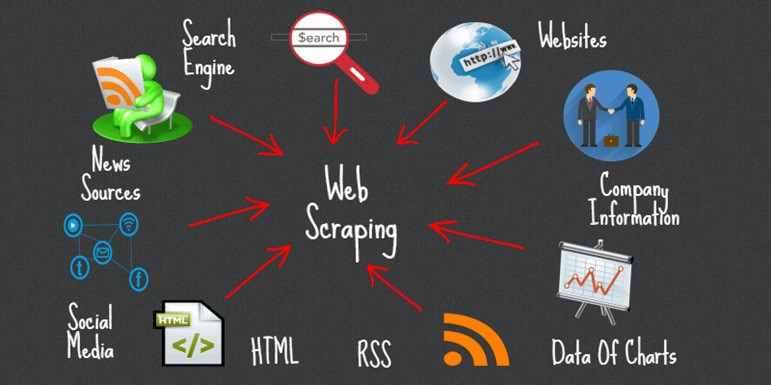Learn Web Scraping from scratch using Python’s Beautiful Soup

Learn Web Scraping from scratch using Python’s Beautiful Soup Free Tutorial Download
The incredible amount of data on the Internet is a rich resource for any field of research or personal interest. To effectively harvest that data, you’ll need to become skilled at web scraping. The Python libraries requests and Beautiful Soup are powerful tools for the job. If you like to learn with hands-on examples and you have a basic understanding of Python and HTML, then this tutorial is for you.
In this tutorial, you’ll learn how to:
- Use
requestsand Beautiful Soup for scraping and parsing data from the Web - Walk through a web scraping pipeline from start to finish
- Build a script that fetches job offers from the Web and displays relevant information in your console
This is a powerful project because you’ll be able to apply the same process and the same tools to any static website out there on the World Wide Web. You can download the source code for the project and all examples in this tutorial by clicking on the link below:
Get Sample Code: Click here to get the sample code you’ll use for the project and examples in this tutorial.
Let’s get started!
What Is Web Scraping?
Web scraping is the process of gathering information from the Internet. Even copy-pasting the lyrics of your favorite song is a form of web scraping! However, the words “web scraping” usually refer to a process that involves automation. Some websites don’t like it when automatic scrapers gather their data, while others don’t mind.
If you’re scraping a page respectfully for educational purposes, then you’re unlikely to have any problems. Still, it’s a good idea to do some research on your own and make sure that you’re not violating any Terms of Service before you start a large-scale project. To learn more about the legal aspects of web scraping, check out Legal Perspectives on Scraping Data From The Modern Web.
Why Scrape the Web?
Say you’re a surfer (both online and in real life) and you’re looking for employment. However, you’re not looking for just any job. With a surfer’s mindset, you’re waiting for the perfect opportunity to roll your way!
There’s a job site that you like that offers exactly the kinds of jobs you’re looking for. Unfortunately, a new position only pops up once in a blue moon. You think about checking up on it every day, but that doesn’t sound like the most fun and productive way to spend your time.
Thankfully, the world offers other ways to apply that surfer’s mindset! Instead of looking at the job site every day, you can use Python to help automate the repetitive parts of your job search. Automated web scraping can be a solution to speed up the data collection process. You write your code once and it will get the information you want many times and from many pages.
In contrast, when you try to get the information you want manually, you might spend a lot of time clicking, scrolling, and searching. This is especially true if you need large amounts of data from websites that are regularly updated with new content. Manual web scraping can take a lot of time and repetition.
There’s so much information on the Web, and new information is constantly added. Something among all that data is likely of interest to you, and much of it is just out there for the taking. Whether you’re actually on the job hunt, gathering data to support your grassroots organization, or are finally looking to get all the lyrics from your favorite artist downloaded to your computer, automated web scraping can help you accomplish your goals.
Challenges of Web Scraping
The Web has grown organically out of many sources. It combines a ton of different technologies, styles, and personalities, and it continues to grow to this day. In other words, the Web is kind of a hot mess! This can lead to a few challenges you’ll see when you try web scraping.
One challenge is variety. Every website is different. While you’ll encounter general structures that tend to repeat themselves, each website is unique and will need its own personal treatment if you want to extract the information that’s relevant to you.
Another challenge is durability. Websites constantly change. Say you’ve built a shiny new web scraper that automatically cherry-picks precisely what you want from your resource of interest. The first time you run your script, it works flawlessly. But when you run the same script only a short while later, you run into a discouraging and lengthy stack of tracebacks!
This is a realistic scenario, as many websites are in active development. Once the site’s structure has changed, your scraper might not be able to navigate the sitemap correctly or find the relevant information. The good news is that many changes to websites are small and incremental, so you’ll likely be able to update your scraper with only minimal adjustments.
However, keep in mind that because the internet is dynamic, the scrapers you’ll build will probably require constant maintenance. You can set up continuous integration to run scraping tests periodically to ensure that your main script doesn’t break without your knowledge.
APIs: An Alternative to Web Scraping
Some website providers offer Application Programming Interfaces (APIs) that allow you to access their data in a predefined manner. With APIs, you can avoid parsing HTML and instead access the data directly using formats like JSON and XML. HTML is primarily a way to visually present content to users.
When you use an API, the process is generally more stable than gathering the data through web scraping. That’s because APIs are made to be consumed by programs, rather than by human eyes. If the design of a website changes, then it doesn’t mean that the structure of the API has changed.
However, APIs can change as well. Both the challenges of variety and durability apply to APIs just as they do to websites. Additionally, it’s much harder to inspect the structure of an API by yourself if the provided documentation is lacking in quality.
The approach and tools you need to gather information using APIs are outside the scope of this tutorial. To learn more about it, check out API Integration in Python.
Scraping the Monster Job Site
In this tutorial, you’ll build a web scraper that fetches Software Developer job listings from the Monster job aggregator site. Your web scraper will parse the HTML to pick out the relevant pieces of information and filter that content for specific words.
You can scrape any site on the Internet that you can look at, but the difficulty of doing so depends on the site. This tutorial offers you an introduction to web scraping to help you understand the overall process. Then, you can apply this same process for every website you’ll want to scrape.
Download Learn Web Scraping from scratch using Python’s Beautiful Soup Free
https://horizoncsueastbay-my.sharepoint.com/:u:/g/personal/mford23_horizon_csueastbay_edu/EcbyNVX7QepMthlmtzZU4e4BVUPiYEno7UoEkAIZJs8yXQ
https://bayfiles.com/B39aeck4pf
https://drive.google.com/file/d/1rk2zmcB8wXW7p57fbUBiLct2F_0ZzW2R/view?usp=sharing
https://uptobox.com/ea5ssp0qufpx




